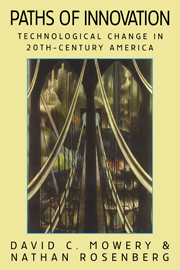3 - The Internal Combustion Engine
Published online by Cambridge University Press: 05 June 2012
Summary
The internal combustion engine, which made the automobile and the airplane possible, is often regarded as the quintessential contribution of American technology to the first half of the 20th century. Nevertheless, the initial development of the gasoline-powered engine was almost entirely a European achievement, dominated by German and French contributors – Carl Benz (a German who operated the first vehicle to be run by an internal combustion engine in 1885), Gottlieb Daimler, Nikolaus Otto, Alphonse Beau de Rochas, Peugeot, Renault, and others.
The development and diffusion of the internal combustion engine illustrate a number of the broader themes that have characterized 20th-century U.S. innovation. The engine's rapid improvement and adoption within the United States were paced by the domestic abundance of low-cost petroleum-based fuels and the strong latent demand for low-cost automotive and air transportation among geographically dispersed U.S. population centers. In some contrast to the later development of new products and processes in the chemicals industry, or the post–World War II development of the electronics industry in the United States, the refinement of the internal combustion engine progressed during the early years of this century with little or no assistance from academic research.
The internal combustion engine also demonstrated the growing importance and often unexpected nature of intersectoral flows of technologies within the U.S. economy.
- Type
- Chapter
- Information
- Paths of InnovationTechnological Change in 20th-Century America, pp. 47 - 70Publisher: Cambridge University PressPrint publication year: 1998



